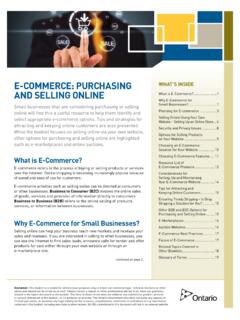Transcription of Case Interview Frameworks
1 Victor Cheng Case Interview Marathon Workshop Victor Cheng s Case Interview Core Frameworks By Victor Cheng These materials provided on an as is basis with no warranty or guarantee expressed or implied. You use them at your own risk. This information is provided to you for free for non-commercial use. You are welcome to forward this to your friends provided you do not alter any of the content and keep the entire document in tact. I retain copyright ownership over these materials ProfitsRevenueCostRevenue/Unit# UnitsSoldCost/Unit# UnitsSoldFixed CostVariableCostFor the problem branch ( , Revenue/Unit or # Units Sold)1) SEGMENT the number, break it up into its component parts,compare to historical metrics to find where the shift is coming from2) ISOLATE the key driver causing bulk of problem3) EXPLORE possible resolutionsPossible Segments to get data for, isolate & explore:* By product / product line* By distribution channel* By region* By customer type (new/old, big/small)* By industry verticalOnce you know mathematically what's causing the problem, you needto understand WHY the number has declined in the context of themarketplace.
2 This may be a "compound framework" problemrequiring you to use a general market analysis framework. If so,most often you will want to start with the customer (demand side)analysis and potentially may have to use the entire problem branch ( , fixed or variable cost)SEGMENT into its component parts* Segment cost by logical components* Segment costs by value chainValue Chain Example:Identify fixed costs in each of the following:Raw Materials -> Factory ->Distribution->CustomersCompare to historical. Find the problem "drilling down" by finding the problem segment,and drill down on THAT segment until you ISOLATE what's mathematically causing the majority of theproblem (aka. Find the LEVERAGE point)PROFITABILITY FRAMEWORK(c) Victor Cheng, for your personal use, free to distribute freely to others provided content and attribution left unalteredTips:1) Keep drilling down until you isolate the problem2) If you realize a branch (or sub-branch) is NOT the problemcome up a level and work the remaining branches3) The name of the game is PROBLEM ISOLATION4) When "units sold" decline, it's useful to compare the company's numbersto its competitors to determine if it's an industry-wide or company-specific issueBUSINESS SITUATION FRAMEWORKNew Market Entry, New Product, New business , How to Grow, Strategy, Turnaround, Company Position AssessmentCustomerCompanyProductCompetit ionWho is the customer?
3 - identify segments (segment size, growth rate, % of total market)- compare current year metrics to historical metrics (look for trends)What does each customer segment want?- identify keys needsWhat price is each segment willing to pay?- determine price points and price elasticity/sensitivityDistribution channel preference for each segmentCustomer concentration and power*(does one customer control all the demand, the " Wal-Mart" effect)Capabilities and expertiseDistribution channelsusedCost structure(mainly fixed vs. variable - is it better to have higher fixed cost with lower variable, or vice fixed cost = barrier to compare to industry, often insightful)Investment cost (optional: only if case involves an investment decision)Intangibles( , brands, brand loyalty)Financial situationOrganizational structure (optional: , is team organization in conflict with how customers want to do : We're organized by product line, but customers want one point of contact across all product lines)Nature of product(think out loud about the product, it's benefits, why someone would buy it)Commodity good or easily differentiable goods(could company increase differentiation)Identifycomplimentary goods(can we piggy back off growth in compliments or near compliments?)
4 Identifysubstitutes*(are we vulnerable to indirect competitors namely substitutes?)Determineproduct's lifecycle(new vs. almost obsolete)Packaging (optional) - what's bundled, included (ex. Razor vs. razor blades, withw/oservice canchange in packaging make product more likely to meet needs of specific customer segments.)Competitor Concentration* & Structure(monopoly, oligopoly, competitive, market shareconcetration)Competitor behaviors (Target customer segments, products, pricing strategy, distribution strategy, brand loyalty)Best practices (are they doing things we're not?)Barriers to entry*(do we need to worry any new entrants to market)?Supplier concentration*(optional: ex: Microsoft or Intel in PC use full 5 forces if this is a likely issue)Industry regulatory environmentLife-cycle of industry(c) Victor Cheng, for your personal use, free to distribute freely to others provided content and attribution left unaltered* From Porter's Five Forces: An excellent framework that I've incorporated into this one.
5 I don't use five forces separately for no other reason thanhabit/preference (though I do use the concepts). If you're not familiar with five forces, it's worth reading up on it.(c) Victor Cheng, for your personal use, free to distribute freely to others provided content and attribution left unalteredMERGERS & ACQUISITIONS "FIT" FRAMEWORKUse this framework when Company A is looking to acquire or merge with Company B, AND the two companies are framework determines if there's a good fit. If Company A & B are nearly identical, use a capacity expansion framework ACompany BCompany A+B"Fit Framework" - General Idea: Use "Core business Situation Framework" and run it for Company A, Company B, and Company A+BThis framework does not answer the question IF it's a good idea to merge/acquire. It assumes you already know that it IS a good ideaand the question is whether or not this particular target company is good fit.
6 To determine IF merging/acquiring is a good idea, useCapacity Expansion Framework insteadIdentify synergy in new companyIdentify opportunities for one-way or mutual exploitation (Classic good "fit" = Company A has huge sales force buy lousy products,Company B has minimalsalesforcebut killer products. Potential sources of synergy: customers, products, distribution, resources,expertise, access to markets, physical assets, unique capabilities, overlapping cost structures)Hint: Every time there's a synergy, that's one vote in the "good fit" column(c) Victor Cheng, for your personal use, free to distribute freely to others provided content and attribution left unalteredCAPACITY CHANGE FRAMEWORKABC Company is considering adding capacity ( , building a new factory), reducing capacity or acquiring a DIRECT is a good framework when understanding industry capacity is the ONLY factor.
7 If there are "fit" issues, use the Mergers &Acquisitions "Fit Framework" ofExpansionDetermine growth in overall market(How sustainable?)Determine Growth in firm's market share(How sustainable?)Segment sources of demand* Determine each segments share of total demand* Identify trends in demand by segmentFocus on the largest sources of demand and thelargest growth use these few "leverage"points help you understand where the majority ofdemand is headingDetermine industry supplySegment industry supply by market / market segmentIdentify effect of increases in supply on pricesPossible BenefitsIntroduce technology innovations with capacityexpansionIncrease productivity -> Lower marginal costsheadingReal costs (can the firm afford it)Opportunity cost- payback period- break even pointAlternatives- outsource- lease- sub-contractFor many if not most capacity related cases, figure out if this is a conceptual case or a numerical case.
8 If conceptual (20% of time), use numerical ( , Company A can produce 20 million units at $4, Company B 10 million units at $ ), then youshould graph out supply curves and overlay them with demand curves. (Tip: practice drawing demand curves from data quickly)The typical issue is if we add/reduce capacity, what will happen to the market clearing once we know the market clearing price whatimpact does that have on and given that impact should the client add/reduce capacity.(c) Victor Cheng, for your personal use, free to distribute freely to others provided content and attribution left unalteredCASE Interview REMINDERSC ompare current year metrics to historical toFIND THE TRENDC ompare "company/client" metrics (revenues, gross margins, unit sales, pricing, changes in segment mix, product mix) to competitors' metricsto determine is it aCOMPANY-SPECIFIC or INDUSTRY-WIDE problem since you solve these problems very differentlyTotals and Averages are very AlwaysSEGMENT YOUR METRICSE xample: Total sales are flat, but Segment A represents 20% of sales, and Segment B represents 80%.
9 Segment A grew 100% this year,Segment B declined by 25%.. BUT total sales were FLAT. If you don't segment, youMISS THE WHOLE , ALWAYS you want to segment numbers but aren't sure which way, just say, "It seems like getting a moredetailed breakdown of revenues would be helpful, do we have any more detailed data on revenues. Often the Interview will volunteer thesegmentation pattern"Oh yeah, did I always, alwaysSEGMENT YOUR NUMBERS!Segment revenues (by product, channel, customer type, region) (total revenues, revenues per unit)Segment costs (by fixed vs variable, costs within each segment of value chain) (total costs, cost per unit)Segment customers (by demographics, needs, purchasing patterns, price point, other)Segment competitors (by channel, region, product, customer segment)Think Out Loud(Usually in response to receiving some data and realizing your hypothesis is right or wrong)Ignoreyour previous knowledge andonlyuse data from the cas




